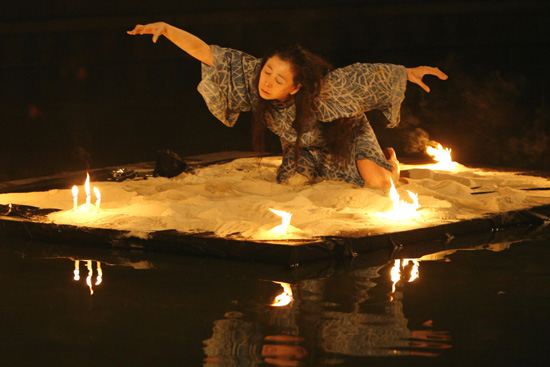Artist-in-Residence Teaches “Delicious Movements” to Spur Body Movement
 |
| Eiko Otake teaches dance at Wesleyan and performs as Eiko & Koma through the Center for the Arts. She encourages her students to show their emotions with or without words. |
| Posted 05/16/07 |
| In Eiko Otakes workshop, students only need to bring their body, and a willingness to move it.
Otake, a visiting instructor for the Department of Dance, teaches a Delicious Movement course, designed for students who love to move with delicious feelings. Dance experience is not a requirement. You dont have to be a dancer to enjoy movement, Otake says. We move and dance to actively forget the clutter of our lives so as to fully taste body and mind. I like to say dance is like dream. It comes and goes. It reflects life but is not bound by it. Like a dream, a dance can bring delicious and/or emotional tastes. In her Spring 2007 course, Delicious Movement for Remembering, Forgetting, and Uncovering, Otake combines dance and movement with study of postwar Japanese arts. The course picks up on the heels of the Spring 2006 course, Japan and the Atomic Bomb, which Otake co-taught with Bill Johnston, professor of East Asian Studies, Science in Society and history, and chair of the Department of History. Learning about human experiences of the atomic bombings is not an easy process, Otake says. How does one express what is essentially inexpressible? But through movement study and discussion, students can learn how to support each others learning process with or without words. We ask, what is it to forget, remember, mourn, and pray? and how does being a mover, a dancer, affect our learning and creativity? Otake encourages students to be compassionate to others and to themselves through appreciation of body, movements and life. Creativity, disobedience, respect to others, flexibility and coordination are all interwoven in her movement studies. Otake, who works as a performer with Eiko & Koma, a New York-based dance and choreography company, first performed at Wesleyan in 2002 with her husband, Koma. In 2004, she began visiting Wesleyan as one of the founding members of Center for Creative Research (CCR), a group consisting of 11 choreographers. In 2005, she started working as a CCR artist-in-residence, teaching students workshops, faculty workshops, guest-teaching other classes, presenting lectures and participating in panels. In the spring of 2006, Eiko & Koma presented Cambodian Stories with 10 young Cambodian artists at the Center for the Arts. Recently, the Otakes have focused on presenting outdoor works, such as the River, The Caravan Project, Offering, and Tree Song, as free events in public sites. Eiko Otake believes she is most human when she is dancing.
Eiko & Koma have received many honors, starting with being named John Simon Guggenheim Memorial Foundation Fellows for 1984. They were awarded one of the first New York Dance and Performance “Bessies” in 1984 for Grain and Night Tide, and were honored again in 1990 for Passage. They were named MacArthur Fellows in June of 1996, and they received the Samuel H. Scripps American Dance Festival Award for lifetime contributions to the field of modern dance in 2004. Recently, they received the 2006 Dance Magazine Award, and this year, they were recognized by the United States Artists as one of the 50 finest living artists across the fields. Eiko and Koma Otake didnt move to the United States until 1976. They were law and political science students in Japan when, in 1971, they each joined a dance company in Tokyo. What began as an experiment turned into an exclusive partnership, and Eiko & Koma started working together in Tokyo. Eiko & Koma will spend the summer researching and planning new works in North Carolina and Alaska. Eiko Otake is planning to return to Wesleyan in Spring 2008 to teach another Delicious Movement class. Her ties to Wesleyan are growing through her family, as well. Her son, Yuta, is graduating from Wesleyan this month; her other son, Shin, is member of the Class of 2010. I love that my relationship with Wesleyan is so multi-layered, she says. |
| By Olivia Drake, The Wesleyan Connection editor. Photos by Rose Eichenbaum, top, and Varga Mtyas, bottom. |


 Through dance Koma and I would like to present our bodies as parts of archaic landscape. Mountains and rivers dance too, Otake explains. Through dancing we can also momentarily forget that we are human. Dance is the oldest art form, yet we treat performances as contemporary rituals.
Through dance Koma and I would like to present our bodies as parts of archaic landscape. Mountains and rivers dance too, Otake explains. Through dancing we can also momentarily forget that we are human. Dance is the oldest art form, yet we treat performances as contemporary rituals.